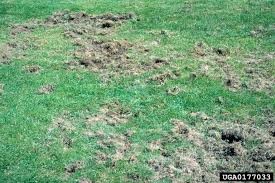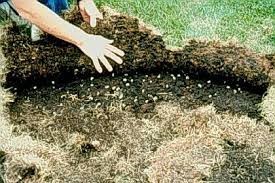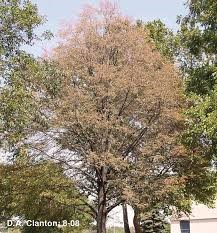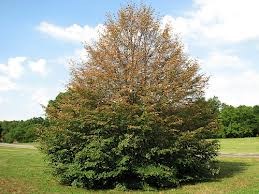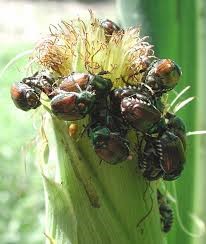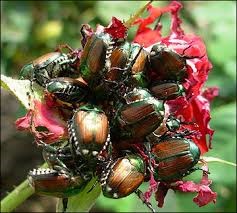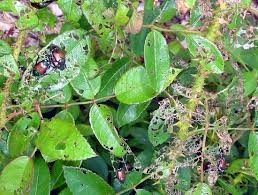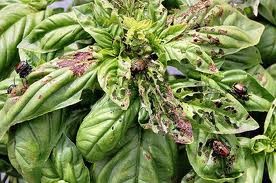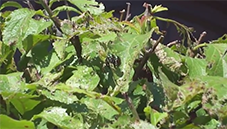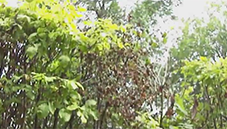Japanese Beetle (JB)
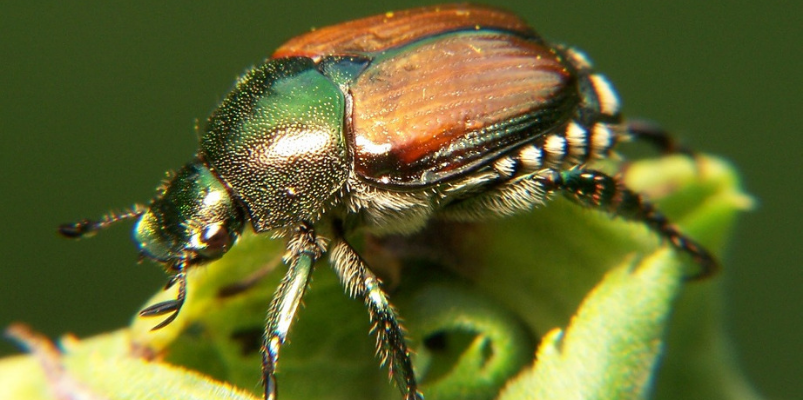
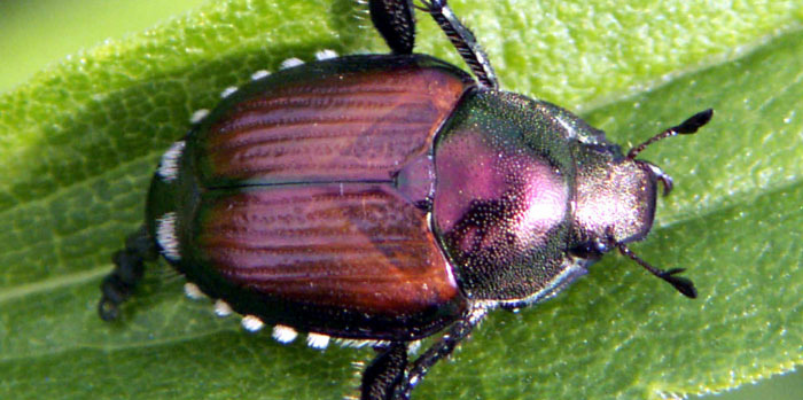
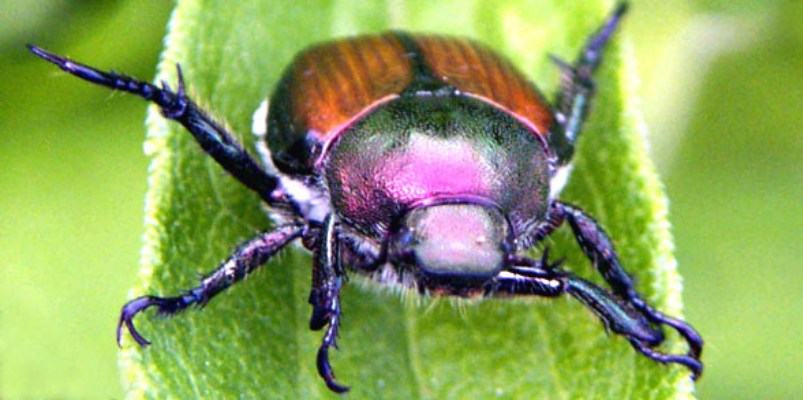
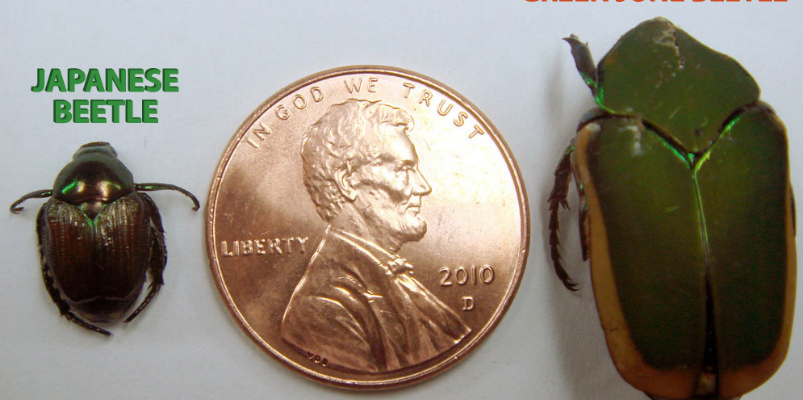
No quarantines at this time.
-
2025 JB Project Decisions
- Carmichael – Treatment
- 179 JB adults detected in 2024
- Delimitation trapping beginning April 1, 2025
- Los Angeles Airport – No treatment
- One JB adult detected in high risk trapping in 2024
- 25 traps per square mile beginning May 1, 2025 (standard high hazard density)
- Los Angeles High Hazard Site – No treatment
- One JB adult detected in high risk trapping in 2024
- 25 traps per square mile beginning May 1, 2025 (standard high hazard density)
- Ontario Airport – No treatment
- One JB adult detected in high risk trapping in 2024
- 25 traps per square mile beginning May 1, 2025 (standard high hazard density)
- Rancho Cordova – Treatment
- One JB adult detected in 2024
- Delimitation trapping beginning April 1, 2025
- Sacramento Airport – No Treatment
- Two JB adults detected in high risk trapping in 2024
- 25 traps per square mile beginning May 1, 2025 (standard high hazard density)
- San Diego Airport – No Treatment
- One JB adult detected in high risk trapping in 2024
- 25 traps per square mile beginning May 1, 2025 (standard high hazard density)
- San Diego Hazard Site – No Treatment
- One JB adult detected in high risk trapping in 2024
- 25 traps per square mile beginning May 1, 2025 (standard high hazard density)
- Carmichael – Treatment
-
2024 JB Project Decisions
- Rancho Cordova – Treatment
- Seven JB adults detected in 2022
- Delimitation trapping beginning April 3, 2024
- Sacramento – Treatment
- One JB adult detected in 2022
- Delimitation trapping beginning April 3, 2024
- Sacramento Airport – No treatment
- One JB adult detected in high risk trapping in 2023
- 25 traps per square mile beginning May 1, 2024 (standard high hazard density)
- Sacramento Mather Airport – No treatment
- One JB adult detected in high risk trapping in 2023
- 25 traps per square mile beginning May 1, 2024 (standard high hazard density)
- Rancho Cordova – Treatment
- 2023 JB Project Decisions
- John Wayne Airport – No treatment
- Two JB adults detected in high risk trapping in 2022
- 25 traps per square mile beginning May 1, 2023 (standard high hazard density)
- Los Angeles High Hazard Sites – No treatment
- One JB adult detected in high risk trapping in 2022
- 25 traps per square mile beginning May 1, 2023 (standard high hazard density)
- Rancho Cordova – Treatment
- 7 JB adults detected in 2022
- Delimitation trapping beginning April 3, 2023
- Sacramento – Treatment
- 2 JB adults detected in 2022
- Delimitation trapping beginning April 3, 2023
- San Diego Airport – No treatment
- Two JB adults detected in high risk trapping in 2022
- 25 traps per square mile beginning May 1, 2023 (standard high hazard density)
- John Wayne Airport – No treatment
- 2022 JB Project Decisions
-
-
Los Angeles High Hazard Sites – No treatment
- One JB adult detected in high risk trapping in 2021
- 25 traps per square mile beginning May 1, 2022 (standard high hazard density)
-
Ontario Airport – No treatment
- One JB adult detected in high risk trapping in 2021
- 25 traps per square mile beginning May 1, 2022 (standard high hazard density)
-
Rancho Cordova – Treatment
- 128 JB adults detected in 2021
- Delimitation trapping beginning April 2, 2022
-
Sacramento – Treatment
- 11 JB adults detected in 2021
- Delimitation trapping beginning April 2, 2022
-
San Bernardino Airport – No treatment
- One JB adult detected in high risk trapping in 2021
- Delimitation trapping only beginning May 1, 2022
-
Travis Air Force Base – No treatment
- One JB adult detected in high risk trapping in 2021
- Delimitation trapping only beginning May 1, 2022
-
San Diego Airport – No treatment
- One JB adult detected in high risk trapping in 2021
- 25 traps per square mile beginning May 1, 2022 (standard high hazard density)
-
Van Nuys Airport – No treatment
- One JB adult detected in high risk trapping in 2021
- 25 traps per square mile beginning May 1, 2022 (standard high hazard density)
-
Los Angeles High Hazard Sites – No treatment
- 2021 JB Project Decisions
-
-
LAX – No treatment
- Three JB adults detected in high risk trapping in 2020
- 25 traps per square mile beginning May 1, 2021 (standard high hazard density)
-
Los Angeles High Hazard Sites – No treatment
- Two JB adults detected in high risk trapping in 2020
- 25 traps per square mile beginning May 1, 2021 (standard high hazard density)
-
March Air Reserve Base – No Treatment
- One JB adult detected in high risk trapping in 2020
- 25 traps per square mile beginning May 1, 2020 (standard high hazard density)
-
North Hollywood High Hazard Site – No treatment
- One JB adult detected in high risk trapping in 2020
- 25 traps per square mile beginning May 1, 2021 (standard high hazard density)
-
Ontario Airport – No treatment
- One JB adult detected in high risk trapping in 2020
- 25 traps per square mile beginning May 1, 2021 (standard high hazard density)
-
Rancho Cordova – Treatment
- 64 JB adults detected in 2020
- Delimitation trapping beginning April 2, 2021
-
Sacramento – Treatment
- 28 JB adults detected in 2020
- Delimitation trapping beginning April 2, 2021
-
Sacramento Mather Airport – No treatment
- Two JB adults detected in high risk trapping in 2020
- Delimitation trapping only beginning May 1, 2021
-
San Diego Airport – No treatment
- One JB adult detected in high risk trapping in 2020
- 25 traps per square mile beginning May 1, 2021 (standard high hazard density)
-
San Diego High Hazard Site – No treatment
- One JB adult detected in high risk trapping in 2020
- 25 traps per square mile beginning May 1, 2021 (standard high hazard density)
-
West Sacramento High Hazard Site – No treatment
- One JB adult detected in high risk trapping in 2020
- 25 traps per square mile beginning May 1, 2021 (standard high hazard density)
-
LAX – No treatment
- 2020 JB Project Decisions
-
-
Burbank Airport – No treatment
- One JB adult detected in high risk trapping in 2019
- 25 traps per square mile beginning May 1, 2020 (standard high hazard density)
-
LAX – No treatment
- Three JB adults detected in high risk trapping in 2019
- Delimitation trapping only beginning May 1, 2020
-
Santa Ana Airport – No treatment
- One JB adult detected in high risk trapping in 2019
- 25 traps per square mile beginning May 1, 2020 (standard high hazard density)
-
Mather Field – No treatment
- Four JB adults detected in high risk trapping in 2019
- Delimitation trapping only beginning May 1, 2020
-
Sacramento Airport – No treatment
- One JB adult detected in high risk trapping in 2019
- 25 traps per square mile beginning May 1, 2020 (standard high hazard density)
-
Ontario Airport – No treatment
- Six JB adults detected in high risk trapping in 2019
- 25 traps per square mile beginning May 1, 2020 (standard high hazard density)
-
San Diego Airport – No treatment
- Seven JB adults detected in high risk trapping in 2019
- Delimitation trapping only beginning May 1, 2020
-
Stockton Airport – No treatment
- One JB adult detected in high risk trapping in 2019
- 25 traps per square mile beginning May 1, 2020 (standard high hazard density)
-
Cerritos High Hazard Site – No treatment
- No JB life stages detected in 2019
- 25 traps per square mile beginning May 1, 2020 (standard high hazard density)
-
Hawaiian Gardens – No treatment
- No JB life stages detected in 2019
- Reverts to standard detection levels, 2 traps per square mile, as delimitation trapping has ended
-
Fair Oaks – No treatment
- No JB life stages detected in 2019
- Reverts to standard detection levels, 2 traps per square mile, as delimitation trapping has ended
-
Goleta – No treatment
- No JB life stages detected in 2019
- Reverts to standard detection levels, 2 traps per square mile, as delimitation trapping has ended
-
Seaside – No treatment
- No JB life stages detected in 2019
- Reverts to standard detection levels, 2 traps per square mile, as delimitation trapping has ended
-
Salinas – No treatment
- No JB life stages detected in 2019
- Reverts to standard detection levels, 2 traps per square mile, as delimitation trapping has ended
-
Burbank Airport – No treatment
- 2019 JB Project Decisions
-
-
Carmichael - No treatment
- No JB life stages detected in 2018
- Reverts to standard detection levels, 2 traps per square mile, as project has ended
-
Cerritos - No treatment
- No JB life stages detected in 2018
- 25 traps per square mile beginning May 1, 2019 (standard high hazard density)
-
Fair Oaks - No treatment
- No JB life stages detected in 2018
- Delimitation trapping only beginning May 1, 2019
-
Goleta - No treatment
- No JB life stages detected in 2018
- Delimitation trapping only beginning May 1, 2019
-
Hawaiian Gardens - No treatment
- No JB life stages detected in 2018
- Delimitation trapping only beginning May 1, 2019
-
La Palma - No treatment
- No JB life stages detected in 2018
- Reverts to standard detection levels, 2 traps per square mile, as project has ended
-
Salinas - No treatment
- 4 JB adults found in a regulatory situation in 2018
- Delimitation trapping only beginning May 1, 2019
-
Seaside - No treatment
- 2 JB adults detected in 2018
- Delimitation trapping only beginning May 1, 2019
-
Stockton Airport - No treatment
- 21 JB adults detected in 2018
- Delimitation trapping only beginning May 1, 2019 surrounding find sites plus 5 traps per square mile in buffers 2 and 3
-
Carmichael - No treatment
- 2018 JB Project Decisions
-
-
Carmichael - No treatment
- No JB life stages detected in 2017
- Enhanced delimitation trapping beginning May 1, 2018
- Cerritos - No treatment
- One JB life adult detected in 2017
- 25 traps per square mile beginning May 1, 2018 (standard high hazard density)
-
Fair Oaks - No treatment
- One JB life adult detected in 2017
- Delimitation trapping only beginning May 1, 2018 surrounding new find site
- Other areas revert to standard detection levels, 2 traps per square mile, as project has ended
-
Goleta - No treatment
- One JB adult detected in 2017
- Delimitation trapping beginning May 1, 2018 surrounding new find site
-
Hawaiian Gardens - No treatment
- One JB life adult detected in 2017
- Delimitation trapping only beginning May 1, 2018 surrounding new find site
-
La Palma - No treatment
- No JB life stages detected in 2017
- Delimitation trapping beginning May 1, 2018 surrounding new find site
-
Stockton Airport - No treatment
- 28 JB adults detected in 2017
- Delimitation trapping only beginning May 1, 2018 surrounding find sites plus 5 traps per square mile in buffers 2 and 3
-
Sunnyvale - No treatment
- No JB life stages detected in 2017
- Reverts to standard detection levels, 2 traps per square mile, as project has ended
-
Carmichael - No treatment
- 2017 JB Project Decisions
-
2024 JB Detections
- Trap detections outside high risk facilities (180 adults):
- 179 adults in Carmichael and 1 adult in Rancho Cordova (Sacramento County)
- Regulatory inspection outside high risk facilities (0 adults):
- No JB life stages detected in regulatory inspections in 2024
- Trap detections at high risk facilities:
- 7 adults at airports and freight forward facilities in Los Angeles, Sacramento, San Bernardino, and San Diego counties.
- Aircraft visual inspection detections (untrapped):
- Adults found on 78 aircraft at airports in Alameda, Fresno, Los Angeles, Orange, Riverside, Sacramento, San Bernardino, and San Diego counties.
- Trap detections outside high risk facilities (180 adults):
-
2023 JB Detections
- Trap detections outside high risk facilities (0 adults):
- No JB life stages detected outside high risk facilities in 2023
- o Regulatory inspection outside high risk facilities (0 adults):
- No JB life stages detected in regulatory inspections in 2023
- Trap detections at high risk facilities:
- 2 adults at airports and freight forward facilities in Sacramento county.
- Aircraft visual inspection detections (untrapped):
- Adults found on 17 aircraft at airports in Alameda, Los Angeles, Orange, Sacramento, San Bernardino, and San Diego counties.
- Trap detections outside high risk facilities (0 adults):
- 2022 JB Detections
-
-
Trap detections outside high risk facilities (9 adults):
- 2 adults in Sacramento and 7 adults in Rancho Cordova (Sacramento County)
-
Regulatory inspection outside high risk facilities (0 adults):
- No JB life stages detected in regulatory inspections in 2022
-
Trap detections at high risk facilities:
- 5 adults at airports and freight forward facilities in Los Angeles, Orange, and San Diego counties.
-
Aircraft visual inspection detections (untrapped):
- Adults found on 116 aircraft at airports in Alameda, Fresno, Los Angeles, Riverside, Sacramento, San Bernardino, San Diego, and San Joaquin counties.
-
Trap detections outside high risk facilities (9 adults):
- 2021 JB Detections
-
-
Trap detections outside high risk facilities (139 adults):
- 11 adults in Sacramento and 128 adults in Rancho Cordova (Sacramento County)
-
Regulatory inspection outside high risk facilities (0 adults):
- No JB life stages detected in regulatory inspections in 2020
-
Trap detections at high risk facilities:
- 8 adults at airports and freight forward facilities in Los Angeles, Sacramento, San Bernardino, San Diego, and Solano counties.
-
Aircraft visual inspection detections (untrapped):
- Adults found on 143 aircraft at airports in Alameda, Fresno, Los Angeles, Orange, Riverside, Sacramento, San Bernardino, San Diego, and San Joaquin counties.
-
Trap detections outside high risk facilities (139 adults):
- 2020 JB Detections
-
-
Trap detections outside high risk facilities (92 adults):
- 28 adults in Sacramento and 64 adults in Rancho Cordova (Sacramento County)
-
Regulatory inspection outside high risk facilities (0 adults):
- No JB life stages detected in regulatory inspections in 2020
-
Trap detections at high risk facilities:
- 13 adults at airports and freight forward facilities in Los Angeles, Riverside, Sacramento, San Bernardino, and San Diego counties.
- Adults found on 221 aircraft at airports in Alameda, Fresno, Los Angeles, Riverside, Sacramento, San Bernardino, San Diego, and San Joaquin counties.
-
Trap detections outside high risk facilities (92 adults):
- 2019 JB Detections
-
-
Trap detections outside high risk facilities (0 adults):
- No JB adults detected in traps outside high risk facilities in 2019
-
Regulatory inspection outside high risk facilities (0 adults):
- No JB life stages detected in regulatory inspections in 2019
-
Trap detections at high risk facilities:
- 24 adults at airports and freight forward facilities in Los Angeles, Orange, Sacramento, San Bernardino, San Diego, and San Joaquin counties.
-
Aircraft visual inspection detections (untrapped):
- Adults found on 518 aircraft at airports in Alameda, Los Angeles, Orange, Riverside, Sacramento, San Bernardino, San Diego, San Joaquin, and Santa Clara counties.
-
Trap detections outside high risk facilities (0 adults):
- 2018 JB Detections
-
-
Trap detections outside high risk facilities (2 adults):
- 2 adults in Seaside (Monterey County)
-
Regulatory inspection outside high risk facilities (4 adults):
- 4 adults in Salinas (Monterey County)
-
Trap detections at high risk facilities:
- 46 adults at airports and freight forward facilities in Los Angeles, Sacramento, San Bernardino, San Diego, San Joaquin, and Santa Clara counties.
-
Aircraft visual inspection detections (untrapped):
- Adults found on 871 aircraft at airports in Alameda, Los Angeles, Orange, Sacramento, San Bernardino, San Diego, San Joaquin, and Santa Clara counties.
-
Trap detections outside high risk facilities (2 adults):
- 2017 JB Detections
- 2016 JB Detections
How We Can Stop the Japanese Beetle:
Final JB SAP Recommendations PowerPoint Presentations and Recordings ofJB SAP Webinars
The Japanese beetle (JB), Popillia japonica, is native to Japan. Adults feed on the fruit, flowers, and leaves of a wide variety of plants, while the larvae live underground and feed on roots and decaying material, favoring grass roots. JB is most common on the northern Japanese islands of Honshu and Hokkaido. It is not common on the more southern islands of Japan because it competes with other related species and because these islands lack the abundant grasslands of the north that are conducive to JB larval feeding. It is not considered much of a pest even on the northern islands because population levels remain constrained by the cool climate, which causes the JB to have a two-year life cycle, and by a parasitic fly that is well synchronized with the JB life cycle.
In 1916, JB was discovered in a nursery in New Jersey, possibly arriving inadvertently in potted bulbs from Japan. The environment it encountered in the United States (US) was warmer than its native range, and this allowed it to complete its life cycle in only one year, leading to a more rapid population buildup than in its native range. In addition, the abundance of grass grown in lawns in urban areas provided a ready larval food source, and this combined with the absence of its main parasitic fly further allowed the fledgling infestation to grow quickly and spread. As a result, in the 100 years since it was discovered in the U.S., it has completely colonized 20 states and partially infested another 15. Its US distribution now ranges from Maine south to Georgia and westward to the Mississippi River, with additional areas scattered across the Great Plains to central Colorado. California has historically been free of JB, but has experienced the occasional infestation. These infestations have been aggressively eradicated when found, and this has allowed the state to maintain its nationally-recognized JB-free status.
No, JB is not established in California. While the JB is established in most eastern states, it is not established in California or the rest of the western US. As localized infestations are detected here, we work to isolate and eradicate them before they can become footholds that could lead to wider infestation and establishment.
California maintains a five part pest prevention system composed of 1) Pest Exclusion to prevent the introduction and spread within the state of newly introduced pests, 2) Pest Detection to detect incipient infestations as soon as possible, 3) Pest eradication to eliminate incipient infestations when feasible, 4) Pest Management for infestations that are not feasible to eradicate but which can be controlled, and 5) Pest Identification and Outreach to ensure timely and accurate identification of pests and to educate the public about pest management activities.
The United States Department of Agriculture maintains a JB Federal Domestic Quarantine (7CFR section 301.48) which enables the regulation of any airport or portions of an airport in a quarantined state. Regulated airlines are required to implement safeguards to prevent JB from entering the cargo holds and passenger areas of planes. Planes landing in this state from high risk regulated airports are inspected upon arrival for the presence of JB. In California, such inspections have occurred since 1960. In 2020, inspections yielded the interception of 291 Japanese beetles, with 3% of all 7,313 aircraft inspected found with one or more beetles.
CDFA maintains a JB State Exterior Quarantine (Title 3, CCR, section 3280) which prohibits all containerized nursery stock and plants with roots and soil from entering the state unless it meets the quarantine certification requirements. We inspect shipments at 16 strategically located Border Protection Stations (BPS) on our highways to ensure compliance with this regulation prior to entry into the state. BPS staff also inspect shipments of nursery stock and potted plants for JB larva and pupa that may be hiding in the soil and roots.
For packages being shipped to California, the County Agricultural Commissioners’ staffs perform inspections of incoming shipments at Postal/Fed Ex/UPS facilities. Our Dog Team Program strategically places inspector dogs and their handlers in various counties to increase the efficacy and efficiency of package inspections at the Postal/Fed Ex/UPS facilities. The dogs are trained by the USDA to detect packages containing plant material. County staff also perform destination inspections of incoming nursery stock arriving from states under quarantine for JB.
Rejections in California
The following tables summarize the Japanese beetle interceptions by multiple facets of our pest exclusion system.
PDR, Rejections and Interception Totals for 2005-2019
| Partial year | Interceptions | Rejections | PDRs | Totals |
|---|---|---|---|---|
| 2005 | 0 | 12 | 5 | 17 |
| 2006 | 0 | 7 | 14 | 21 |
| 2007 | 0 | 11 | 51 | 62 |
| 2008 | 0 | 7 | 28 | 35 |
| 2009 | 218 | 7 | 5 | 230 |
| 2010 | 251 | 26 | 10 | 287 |
| 2011 | 272 | 45 | 6 | 323 |
| 2012 | 337 | 36 | 14 | 387 |
| 2013 | 103 | 18 | 1 | 122 |
| 2014 | 108 | 36 | 5 | 149 |
| 2015 | 18 | 177 | 10 | 1205 |
| 2016 | 120 | 210 | 22 | 352 |
| 2017 | 150 | 233 | 42 | 425 |
| 2018 | 373 | 8 | 38 | 419 |
| 2019 | 393 | 320 | 16 | 729 |
| 2020 | 386 | 256 | 0 | 642 |
| 2021 | 542 | 335 | 0 | 877 |
| 2022 | 458 | 321 | 0 | 779 |
| 2023 | 446 | 300 | 0 | 746 |
| 2024 | 546 | 355 | 0 | 901 |
| Totals | 4721 | 2720 | 267 |
***database collection did not begin until 2009
Interceptions = shipments of JB host material.
Rejections = shipments arriving which are not in compliance with our JB Exterior Quarantine requirements and denied entry.
PDRs = JB actually detected.
JB Airport Interceptions
| County | Total | 2004 | 2005 | 2006 | 2007 | 2008 | 2009 | 2010 | 2011 | 2012 | 2013 | 2014 | 2015 | 2016 | 2017 | 2018 | 2019 | 2020 | 2021 | 2022 | 2023 | 2024 |
|---|---|---|---|---|---|---|---|---|---|---|---|---|---|---|---|---|---|---|---|---|---|---|
| Alameda | 244 | 3 | 11 | 1 | 13 | 28 | 41 | 101 | 46 | 37 | 11 | 7 | 1 | 8 | ||||||||
| Fresno | 14 | 4 | 10 | 1 | 3 | 11 | 6 | |||||||||||||||
| Los Angeles | 1392 | 107 | 241 | 221 | 79 | 62 | 15 | 86 | 21 | 38 | 7 | 16 | 25 | 58 | 63 | 180 | 173 | 72 | 62 | 31 | 2 | 39 |
| Orange | 53 | 3 | 3 | 3 | 1 | 2 | 4 | 5 | 17 | 15 | 6 | 2 | 1 | |||||||||
| Riverside | 11 | 11 | 3 | 3 | 1 | 19 | ||||||||||||||||
| Sacramento | 332 | 6 | 2 | 2 | 25 | 4 | 3 | 4 | 2 | 2 | 9 | 68 | 112 | 93 | 26 | 40 | 41 | 2 | 9 | |||
| San Bernardino | 2278 | 13 | 66 | 16 | 20 | 12 | 27 | 24 | 61 | 528 | 1132 | 379 | 105 | 45 | 18 | 4 | 3 | |||||
| San Diego | 481 | 6 | 4 | 5 | 5 | 1 | 8 | 12 | 14 | 51 | 253 | 122 | 36 | 12 | 21 | 10 | 39 | |||||
| San Joaquin | 640 | 133 | 439 | 68 | 11 | |||||||||||||||||
| Santa Clara | 16 | 1 | 1 | 3 | 11 |
These were intercepted on incoming aircraft flights.
| JB County Rejections | 2004 | 2005 | 2006 | 2007 | 2008 | 2009 | 2010 | 2011 | 2012 | 2013 | 2014 | 2015 | 2016 | 2017 | 2018 | 2019 | 2020 | 2021 | 2022 | 2023 |
|---|---|---|---|---|---|---|---|---|---|---|---|---|---|---|---|---|---|---|---|---|
| Alameda | 1 | 3 | 5 | 1 | 2 | 0 | 0 | 0 | 3 | 1 | 19 | 16 | 8 | 0 | 0 | 1 | 3 | 36 | 0 | 1 |
| Butte | 0 | 0 | 0 | 0 | 0 | 0 | 1 | 0 | 0 | 0 | 0 | 0 | 0 | 0 | 0 | 0 | 0 | 1 | 0 | 0 |
| Calaveras | 0 | 0 | 0 | 0 | 0 | 0 | 1 | 3 | 1 | 0 | 1 | 0 | 2 | 1 | 0 | 0 | 0 | 0 | 0 | 0 |
| Contra Costa | 0 | 14 | 14 | 7 | 3 | 5 | 1 | 0 | 2 | 3 | 5 | 5 | 0 | 0 | 11 | 15 | 6 | 0 | 27 | 12 |
| El Dorado | 0 | 0 | 0 | 0 | 1 | 0 | 0 | 0 | 0 | 0 | 0 | 0 | 0 | 0 | 0 | 0 | 0 | 0 | 0 | 0 |
| Fresno | 6 | 0 | 1 | 9 | 8 | 0 | 0 | 1 | 0 | 0 | 0 | 0 | 0 | 0 | 0 | 0 | 0 | 1 | 4 | 3 |
| Humboldt | 0 | 0 | 0 | 13 | 9 | 1 | 0 | 0 | 0 | 0 | 0 | 0 | 0 | 0 | 0 | 0 | 0 | 0 | 0 | 0 |
| Los Angeles | 0 | 0 | 0 | 0 | 0 | 0 | 0 | 0 | 1 | 0 | 0 | 0 | 0 | 0 | 0 | 0 | 15 | 35 | 18 | 32 |
| Orange | 0 | 0 | 0 | 1 | 0 | 1 | 0 | 0 | 0 | 0 | 0 | 0 | 0 | 0 | 0 | 0 | 0 | 2 | 0 | 0 |
| Placer | 4 | 6 | 1 | 0 | 0 | 1 | 1 | 1 | 1 | 5 | 3 | 0 | 0 | 0 | 0 | 0 | 0 | 0 | 0 | 0 |
| Riverside | 0 | 0 | 0 | 0 | 3 | 0 | 0 | 0 | 0 | 0 | 0 | 0 | 0 | 0 | 0 | 0 | 0 | 0 | 0 | 0 |
| Sacramento | 1 | 6 | 0 | 0 | 3 | 6 | 2 | 1 | 0 | 1 | 0 | 0 | 0 | 0 | 0 | 0 | 0 | 0 | 0 | 0 |
| San Bernardino | 0 | 0 | 0 | 3 | 22 | 1 | 0 | 2 | 0 | 0 | 0 | 0 | 0 | 0 | 0 | 0 | 3 | 2 | 5 | 2 |
| San Diego | 4 | 0 | 0 | 0 | 1 | 0 | 0 | 0 | 0 | 0 | 4 | 0 | 0 | 0 | 0 | 0 | 0 | 0 | 0 | 0 |
| San Joaquin | 1 | 0 | 3 | 1 | 0 | 0 | 0 | 0 | 0 | 0 | 0 | 0 | 0 | 0 | 0 | 0 | 0 | 0 | 0 | 0 |
| San Luis Obispo | 6 | 8 | 11 | 0 | 2 | 1 | 0 | 0 | 0 | 0 | 0 | 0 | 0 | 0 | 0 | 0 | 1 | 0 | 0 | 1 |
| San Mateo | 1 | 1 | 0 | 0 | 0 | 1 | 0 | 2 | 0 | 2 | 0 | 0 | 0 | 0 | 0 | 0 | 11 | 8 | 24 | 35 |
| Santa Barbara | 0 | 0 | 0 | 2 | 1 | 0 | 1 | 1 | 1 | 0 | 0 | 0 | 1 | 0 | 0 | 0 | 0 | 1 | 0 | 0 |
| Santa Clara | 4 | 2 | 0 | 0 | 0 | 0 | 0 | 1 | 0 | 0 | 2 | 0 | 0 | 0 | 0 | 0 | 13 | 8 | 3 | 2 |
| Santa Cruz | 32 | 31 | 31 | 10 | 15 | 11 | 0 | 3 | 0 | 1 | 12 | 1 | 0 | 0 | 0 | 0 | 1 | 9 | 57 | 1 |
| Shasta | 1 | 0 | 0 | 0 | 0 | 0 | 0 | 0 | 0 | 0 | 0 | 0 | 0 | 0 | 0 | 0 | 0 | 0 | 0 | 0 |
| Solano | 0 | 0 | 0 | 0 | 32 | 0 | 0 | 0 | 0 | 0 | 0 | 0 | 0 | 0 | 0 | 0 | 67 | 4 | 5 | 4 |
| Sonoma | 0 | 2 | 7 | 9 | 2 | 1 | 0 | 0 | 0 | 0 | 0 | 0 | 0 | 1 | 0 | 6 | 3 | 4 | 2 | 13 |
| Tulare | 2 | 0 | 1 | 0 | 0 | 0 | 0 | 0 | 0 | 0 | 0 | 0 | 0 | 0 | 0 | 6 | 0 | 0 | 0 | 0 |
| Yuba | 0 | 0 | 0 | 0 | 0 | 3 | 0 | 0 | 0 | 0 | 0 | 0 | 0 | 0 | 0 | 0 | 0 | 1 | 0 | 0 |
These are rejections made of incoming parcel shipments which do not meet the requirements of our JB Exterior Quarantine.
CDFA also conducts inspections of outdoor items from the east coast for the spongy moth. During these inspections an adult JB was found in Orange County in 2007 and Humboldt County in 2015 associated with outdoor items being moved here from the east coast. In 2011 the Fresno County dog team intercepted JB in a single plant being shipped into the state through a parcel service.
In California, trapping for JB has occurred for many years. Approximately 12,000 traps are placed and monitored statewide during the JB flight season. General residential trapping for JB is currently conducted at two traps per square mile. If a JB is detected, then intensive trapping is triggered. The objective is to determine the extent and epicenter of an infestation. The trap density is increased to 50 traps within the one-square-mile core surrounding each adult find (0.5-mile radius). This may be increased to 100, 160 or 640 traps to further refine the data about the population if additional beetles are detected, and additional traps may be placed in the buffers. In addition, the trap density is 25 traps per square mile in a one-mile buffer area surrounding the core, and five traps per square mile in a two-mile buffer area surrounding this buffer, thereby resulting in a 49-square-mile area (3.5-mile radius). Traps in the core are monitored daily and buffer traps are monitored at least once during the first week following a detection, and all traps are monitored weekly thereafter. Visual surveys may occur up to 400 meters around each detection. High hazard JB trapping is also conducted around airports and DHL/FedEx/UPS facilities. In California, trapping at airports was first implemented in 1945.
Despite the numerous instances in which our efforts have succeed in keeping JB from entering California, the pest has been introduced into and caused incipient infestations several times in the state. The following is a chronology of JB eradications in California. Each time JB has been introduced, it has been successfully eradicated. The fact that JB has been introduced numerous times into the state and subsequently eradicated supports the contention that JB can be successfully eradicated from the two current infestations in Sacramento County.
Japanese Beetle Eradications in California
| Year(s) of Finds | City | County | Adults | Larvae |
|---|---|---|---|---|
| 1951* | Lennox (LAX) | Los Angeles | 1 | 0 |
| 1954* | Hawthorne (LAX) | Los Angeles | 1 | 0 |
| 1956* | Fairfield (TAFB) | Solano | 1 | 0 |
| 1961-1962 | Sacramento/West Sacramento | Sacramento/Yolo | 449 | 71 |
| 1973-1974 | Balboa Park | San Diego | 24 | 0 |
| 1974* | San Diego (SAN) | San Diego | 1 | 0 |
| 1983-1984** | Orangevale/Citrus Heights | Sacramento | 93 | 8 |
| 2002* | Rancho Cordova (MHF) | Sacramento | 5 | 0 |
| 2006-2007 | Vista | San Diego | 3 | 0 |
| 2010-2012, 2014 | Fair Oaks | Sacramento | 10 | 0 |
| 2014-2015 | Carmichael | Sacramento | 10 | 0 |
| 2015 | Sunnyvale | Santa Clara | 2 | 0 |
| 2019-2022 | Sacramento/Rancho Codova | Sacramento | 240 | 0 |
* = Trapped at or near Los Angeles Airport (LAX), Mather Field Airport (MHF), San Diego Airport (SAN), or Travis Air Force Base (TAFB). Considered quarantine treatments at point of introduction.
** = This was the only time CDFA implemented a JB Interior Quarantine, from 1983-87.
1987 to 2015
The two lists below include all beetles trapped or visually collected in the environment in Sacramento County since 1987 (the earliest year for which records have been entered into the CDFA electronic records database). The lists do not include beetles found on planes during inspections.
A. High Hazard Detections - Trapped
This list summarizes the JB trapped at or just outside the two major airports for cargo planes in Sacramento County, namely Sacramento International (SMF) and Mather Field (MHF). They are presumed to be the result of JB leaving the planes upon arrival, so they normally do not trigger treatments. However, because there were five beetles in 2002 at Mather Field, the CDFA did treat the turf on the airport and 16 bordering trailer park properties with imidacloprid that year as a precaution.
| Year | Detections | Location |
|---|---|---|
| 1991 | 1 | SMF |
| 1996 | 2 | MHF and SMF |
| 2000 | 1 | MHF |
| 2002 | 5 | MHF |
| 2003 | 2 | MHF and SMF |
| 2005 | 1 | SMF |
| 2006 | 2 | MHF |
| 2011 | 1 | SMF |
| 2012 | 1 | MHF |
| 2017 | 5 | MHF and SMF |
| 2018 | 54 | MHF and SMF |
| 2019 | 5 | MHF and SMF |
| 2020 | 3 | MHF and SMF |
| 2023 | 2 | SMF |
| 2024 | 2 | SMF |
B. Residential Detections - Trapped or Visual
This list summarizes the JB trapped or collected visually in residential neighborhoods outside of the high hazard airport trapping in Sacramento County.
| Year | Detections | Location and Comments |
|---|---|---|
| 1999 | 1 | Fair Oaks; 2.5 miles SE of current Fair Oaks and 4.3 miles NE of current Carmichael infestations; trapped; no treatment |
| 1998 | 1 | Carmichael; 620 meters NE of first find in current Carmichael project; adult reportedly collected by resident who turned it in said it was collected at that address "a number of years ago"; no treatment |
| 2010 | 1 | Fair Oaks; trapped; treatment occurred |
| 2011 | 2 | Fair Oaks; trapped; treatment occurred |
| 2012 | 4 | Fair Oaks; trapped; treatment occurred |
| 2014 | 3 | Fair Oaks; trapped; treatment occurred |
| 2014 | 3 | Carmichael; trapped; treatment occurred |
| 2015 | 7 | Carmichael; trapped; treatment occurred |
| 2020 | 88 | Sacramento and Rancho Cordova; trapped; treatment occurred |
| 2021 | 139 | Sacramento and Rancho Cordova; trapped; treatment occurred |
| 2022 | 9 | Sacramento and Rancho Cordova; trapped; treatment occurred |
At the project sites impartial third-party monitoring is conducted. A pesticide monitoring program is used to evaluate program effectiveness and environmental impact. Pesticide monitoring is a cooperative effort involving state and county personnel. The evaluation is designed to effectively address agency, cooperator, and public concerns.
The Sacramento County Agricultural Commissioner's Pesticide Use Enforcement staff makes regular inspections of mixing/loading, equipment and treatment activities, and pesticide container storage.
CDPR's Division of Pest Management Environmental Hazards Assessment Program staff monitor for detectable levels of pesticides in and around treatment areas. This may include sampling of air, foliage, food crops, water, soil, or other media. Monitoring results will indicate program effectiveness by measuring persistence of pesticides in pest host materials, and discover any environmental impacts by measuring residues in non-target environmental components.
CDFA has a National Pollutant Discharge Elimination System (NPDES) permit issued by the State Water Resources Control Board to ensure no pollutants are discharged into a body of water. CDFA has never failed to comply with the terms of its NPDES permit.
Sign Up for Updates
Japanese Beetle
Hot Topics
Pest Video
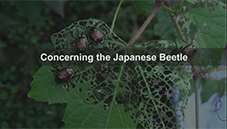
Concerning the Japanese Beetle
Eradicating a serious pest of agriculture, horticulture and landscapes (06:27)


